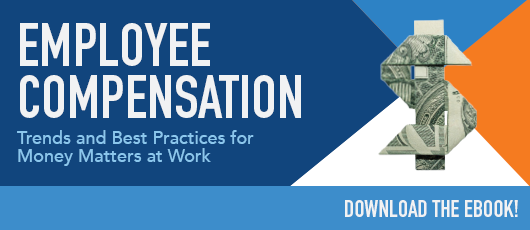6 Ways to Increase Clarity Around Employee Compensation
 People know what they’re getting paid (and generally what they’re getting paid for), but they often lack the context to understand what that really means. Employees want to know:
People know what they’re getting paid (and generally what they’re getting paid for), but they often lack the context to understand what that really means. Employees want to know:
- How does their salary compare to the rest of the marketplace?
- Is it in line with other employees at their organization?
- What could their potential compensation look like?
If these questions go unanswered, employees will make up something to fill the void. And employee engagement will plummet.
Don’t leave your employees wondering! When it comes to employee compensation conversations, clarity is key. Consider these six ways to increase visibility and ensure everyone is on the same page.
1. Adopt an open-door policy.
Honest conversations about compensation help employees understand how their salary compares to industry averages and allow them to express concerns or uncertainties. Don’t be afraid to talk through the pros and cons of making a move. Sure, a larger corporation might offer a higher salary—but they may also offer less opportunity for career growth.
This open dialogue will help both parties cut past formalities and identify the best solution, whether that’s a promotion plan or a parting of ways.
2. Educate your managers.
73% of leaders don’t feel very confident in their managers’ abilities to tackle compensation conversations with employees. HR and organizational leaders should equip managers with the resources they need to have these conversations at all stages of their direct reports’ tenure.
Managers should be able to clearly communicate how an employee’s initial salary was determined, and what the employee needs to do to move up to the next level.
Consider adding compensation training into your manager development program to ensure all managers are well versed in company best practices and industry market data.
3. Give employees access to market data.
What resources do you use to make compensation decisions? Whether it’s Radford, Mercer, internal benchmarks, or some combination of these resources, make your methodology transparent to your entire workforce. HR teams should share the market data used to inform pay decisions and make it easy for employees to access at any time.
4. Create a detailed policy and share it widely.
Is your company’s practice to always pay above the market average, on par, or slightly below? What factors inform salary? Whatever your practice, make sure that everyone from the recruiter to the manager to an entry-level employee understands your approach and the reasoning behind it.
Document how raises and promotions are determined so the process is standardized and clear to anyone considering career growth.
5. Track compensation metrics.
Data is king. Compensation decisions should be data-driven and fueled by market research and internal benchmarking. Build reports to determine how your pay practices compare to industry averages and, as your company grows, make sure you are scaling compensation accordingly. Something as simple as looking at salary data year over year can provide powerful insights into the success of your compensation strategy.
6. Consider full salary transparency.
According to our research, about 17% of private companies practice pay transparency, 41% discourage it, and 25% explicitly prohibit the discussion of salary information. While company-wide salary disclosure isn’t right for every company culture, it is one way to provide full and complete transparency—and accountability—around pay practices.
It’s a huge decision to consider, but if clarity is a priority for your organization, it might be an asset to your employer brand and employee engagement initiatives.
If you’re looking for more trends and best practices on dealing with money matters at work, download our Employee Compensation ebook.







